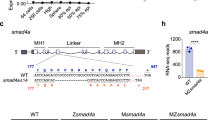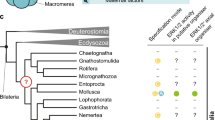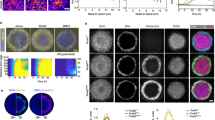Abstract
Controlling the duration of a signalling process in development by loss of competence is important because too strong an induction can change cell fate. To understand some of the mechanisms that underlie loss of competence, we have analysed the transduction of transforming growth factor-β (TGF-β) signalling during mesoderm formation, which is thought to be induced by TGF-β-like signalling1,2, in embryos of the frog Xenopus laevis. Here we show that gastrula ectoderm has the ability to express mesodermal marker genes in response to the TGF-β signalling molecule activin for many hours, but then loses this ability within 1 h for all mesodermal genes tested. This loss of mesodermal competence correlates with the inability of Smad2, the principal intracellular signal transducer of activin, to accumulate in the nucleus. Mutating three phosphorylation sites within Smad2 abrogates the temporal restriction of Smad2 to accumulate in the nucleus. Overexpression of this mutant form of Smad2 can prolong the competence of endogenous mesodermal genes to respond to activin signalling. Thus, restricting the subcellular localization of an intracellular signal transducer constitutes a mechanism that leads to loss of mesodermal competence. This mechanism operates within less than an hour, and is therefore well suited to control an orderly sequence of inductions.
This is a preview of subscription content, access via your institution
Access options
Subscribe to this journal
Receive 12 print issues and online access
$209.00 per year
only $17.42 per issue
Buy this article
- Purchase on Springer Link
- Instant access to full article PDF
Prices may be subject to local taxes which are calculated during checkout




Similar content being viewed by others
References
Schier, A. F. & Shen, M. M. Nature 403, 385–389 (2000).
Whitman, M. Genes Dev. 12, 2445–2462 (1998).
Heldin, C. H., Miyazono, K. & ten Dijke, P. Nature 390, 465–471 (1997).
Massague, J., Blain, S. W. & Lo, R. S. Cell 103, 295–309 (2000).
Woodland, H. R. & Jones, E. A. Development 101, 925–930 (1987).
Green, J. B. A. & Smith, J. C. Nature 347, 391–394 (1990).
Gurdon, J. B., Fairman, S., Mohun, T. J. & Brennan, S. Cell 41, 913–922 (1985).
Smith, J. C., Price, B. M. J., Green, J. B. A., Weigel, D. & Herrmann, B. G. Cell 67, 79–87 (1991).
Cho, K. W., Blumberg, B., Steinbeisser, H. & De Robertis, E. M. Cell 67, 1111–1120 (1991).
Ryan, K., Garrett, N., Mitchell, A. & Gurdon, J. B. Cell 87, 989–1000 (1996).
Sasai, Y. et al. Cell 79, 779–790 (1994).
Lustig, K. D. et al. Development 122, 3275–3282 (1996).
Kretzschmar, M., Doody, J. & Massague, J. Nature 389, 618–622 (1997).
Kretzschmar, M., Doody, J., Timokhina, I. & Massague, J. Genes Dev. 13, 804–816 (1999).
Smith, W. C. & Harland, R. M. Cell 70, 829–840 (1992).
Schohl, A. & Fagotto, F. Development 129, 37–52 (2002).
Coffman, C. R., Skoglund, P., Harris, W. A. & Kintner, C. R. Cell 73, 659–671 (1993).
Steinbach, O. C., Wolffe, A. P. & Rupp, R. A. Nature 389, 395–399 (1997).
Henig, C., Elias, S. & Frank, D. Mech. Dev. 71, 131–142 (1998).
Chen, X., Rubock, M. J. & Whitman, M. Nature 383, 691–696 (1996).
Ryan, A. K. et al. Nature 394, 545–55. (1998).
Wilson, P. A. & Melton, D. A. Curr. Biol. 4, 676–686 (1994).
Danilchick, M., Peng, H. B. & Kay, B. K. Methods Cell Biol. 36, 679–681 (1991).
Shimizu, K. & Gurdon, J. B. Proc. Natl Acad. Sci. USA 96, 6791–6796 (1999).
Acknowledgements
We thank A. Martinez-Arias and A. M. Zorn for comments on the manuscript, and P.-Y. Bourillot for the pT7–GFP–Smad2 construct. O.H.G. is supported by the Boehringer Ingelheim Fonds Research in the lab is funded by the Cancer Research UK and the Wellcome Trust.
Author information
Authors and Affiliations
Corresponding author
Ethics declarations
Competing interests
The authors declare no competing financial interests.
Rights and permissions
About this article
Cite this article
Grimm, O., Gurdon, J. Nuclear exclusion of Smad2 is a mechanism leading to loss of competence. Nat Cell Biol 4, 519–522 (2002). https://doi.org/10.1038/ncb812
Received:
Revised:
Accepted:
Published:
Issue Date:
DOI: https://doi.org/10.1038/ncb812
This article is cited by
-
Smad linker region phosphorylation is a signalling pathway in its own right and not only a modulator of canonical TGF-β signalling
Cellular and Molecular Life Sciences (2020)
-
ERK inhibition promotes neuroectodermal precursor commitment by blocking self-renewal and primitive streak formation of the epiblast
Stem Cell Research & Therapy (2018)
-
Molecular specification of germ layers in vertebrate embryos
Cellular and Molecular Life Sciences (2016)
-
PI3K/mTORC2 regulates TGF-β/Activin signalling by modulating Smad2/3 activity via linker phosphorylation
Nature Communications (2015)
-
Conservation and evolutionary divergence in the activity of receptor-regulated smads
EvoDevo (2012)



